Are heated tobacco products a new health risk?
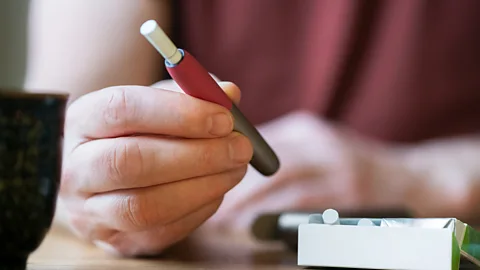 Getty Images
Getty ImagesA new type of tobacco product is finding growing numbers of users around the world, but there are still serious questions about how it affects human health.
Having smoked for nearly 30 years since the age of 13, IT consultant and freelance writer Ben Taylor was intrigued by the sound of heated tobacco products.
Attempting to switch from cigarettes to vapes hadn't worked for Taylor. "Vaping liquids always left me wanting," he posted on his blog. So he decided to try IQOS, a sleek, pen-shaped electronic device that heats sticks of rolled tobacco, developed by the American multinational tobacco company Philip Morris International (PMI).
Rather than burning tobacco, these devices heat it to a temperature high enough to create a vapour but not smoke.
For Taylor, it didn't quite replicate the experience of smoking a cigarette, but it came much closer than vaping – the other popular cigarette alternative, which uses handheld pens to heat a flavoured nicotine-containing liquid. "You can tell you're consuming real tobacco," Taylor wrote. Over time, he says, he came to prefer IQOS due to the taste, and the lack of a lingering cigarette stench. He also says his previously near-permanent cough disappeared.
Tobacco manufacturers that sell heated tobacco devices market them as being a less harmful alternative to cigarettes. They point to industry-funded research that shows they produce lower levels of compounds known to be harmful to human health.
But there is growing concern in the medical community that these devices still pose a health risk to both the people who use them and those standing nearby. They also warn that as relatively new products, the long-term effects of using heated tobacco have still to be properly investigated.
Yet they are also becoming increasingly common, with next-generation heated tobacco products now available in more than 60 countries. They have experienced particularly notable growth in both Italy and Japan, where they have been present since 2014. And this growth is expected to continue as they start to penetrate the market in the US.
So, is heated tobacco really helping people enjoy nicotine in a less harmful way, or could it be a new public health crisis in the making?
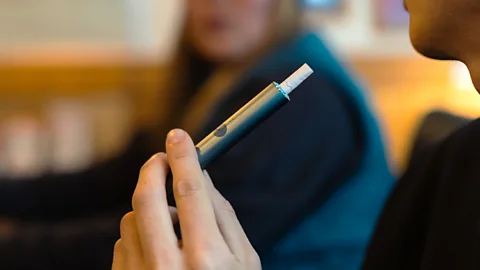 Getty Images
Getty ImagesIQOS and other devices like it are the latest iteration of a concept which the tobacco industry has been intermittently toying with for the past four decades. In 1988, an American tobacco company called RJ Reynolds attempted to commercialise the very first heated tobacco product, a device called Premier. Designed to look similar to a conventional cigarette in shape and size, the Premier had a specifically designed carbon tip that users would light to heat the tobacco. But despite a reported $300m (roughly £180m at the time) in investment, Premier was removed from the market after just six months as users complained about its taste and smell.
After various reinventions, heated tobacco products have started to enjoy commercial success in the past decade with a new range of electronic devices that use several methods to vaporise their contents. Typically these involve encasing tobacco in either sticks, plugs, capsules or pods, which are then heated with an electronic element. As well as PMI's IQOS, leading brands include Ploom, made by Japan Tobacco International (JTI), and glo, made by British American Tobacco (BAT).
Employing sleek, appealing designs and backed by multi-million dollar marketing strategies – which have included everything from social media influencers to pop-up stores – these devices have been far more successful than the original incarnations. Celebrities have backed heated tobacco products, with the musician Jamiroquai and actors Alberto Amman and Monica Cruz attending the IQOS 3 launch party in Madrid in 2019. Jamiroquai also performed at a 2018 launch event for IQOS 3 in Milan, while American dance music DJ Steve Aoki, whose name is attached to a limited edition version of an IQOS device, performed a concert at another event for the products in Barcelona in January 2025.
BAT have also employed similar marketing tactics, paying social media influencers, sponsoring boat parties and organising giveaways at Formula 1 races.
So far, heated tobacco products have had limited penetration in the US. While one survey of 40,000 US adults found that 8% were aware of them, only 0.5% had ever used one of the devices. But that could change. After first receiving a limited authorisation from the US Food and Drug Administration in 2019, which was later extended in 2020, IQOS is now re-entering the US market in Austin, Texas.
The tobacco industry promotes this new generation of heated tobacco products as a safer, smoke-free alternative, stressing that they only heat, not burn tobacco. PMI's website, for example, states that they aim to remove "combustion of tobacco, the cause of most tobacco-related diseases", celebrating IQOS as "the next step in tobacco harm reduction". The company estimates that more than 22 million adults globally have quit smoking cigarettes and switched to its heated tobacco products.
PMI has said in the past that it intends to stop selling cigarettes and become a smoke-free company. It is investing heavily in products such as heated tobacco and hopes for at least two-thirds of its revenues to come from smoke-free products by 2030.
But independent researchers and public health experts argue that heated tobacco products are still harmful to human health and urge users to give up tobacco altogether. They express concerns at some of the marketing strategies, saying that the use of influencers and glamorous launch parties could encourage heated tobacco use among young people, who are more likely not to have smoked before, which could make these products a gateway to cigarettes.
PMI, JTI and BAT all insist their products are aimed at adults only. PMI says it has a robust code of conduct that does not allow marketing that appeals to minors such as cartoons, youth-orientated celebrities or models who are or appear to be under the age of 25. BAT said they carry out due diligence on any influencer partnerships to ensure that a significant majority of their followers are over 18 years old. JTI says it is "committed to the principle that minors should never use or access nicotine-containing products". It says it ensures it markets its heated tobacco products in a "socially responsible way" in accordance with applicable laws and rules.
But Silvano Gallus, an epidemiologist at the Mario Negri Institute for Pharmacological Research in Milan, believes that existing smokers do not appear to be the main audience for these products, despite the messaging from tobacco firms. He first started monitoring the rollout of heated tobacco products more than a decade ago.
"We began to see the promotion of these products everywhere with advertisements, events and parties, particularly aimed at young people," says Gallus, reflecting on the initial launch of heated tobacco in the cities of Milan and Nagoya, Japan.
In 2019, PMI suspended a social media campaign involving digital influencers after the news organisation Reuters revealed the company had been using young online personalities to market its products, including a 21-year-old woman, in breach of its own code of conduct. PMI said at the time that no laws were broken, but acknowledged that the campaign failed to meet the company's standards.
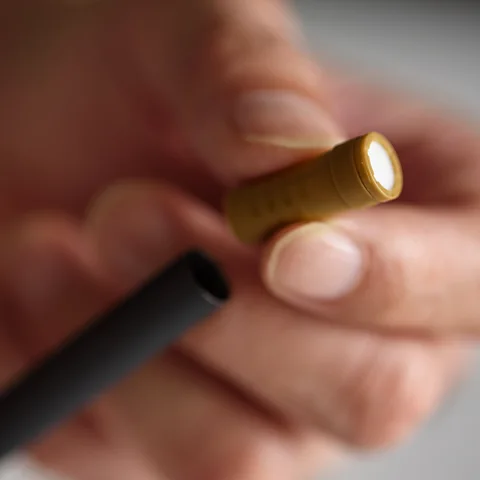 Getty Images
Getty ImagesGallus claims that the users of heated tobacco products in Italy tend to be young, pointing to surveys which have described their use as widespread among adolescents. "They aren't 60-year-old hardcore smokers looking for an alternative to cigarettes," he says.
PMI, however, insists that unintended use among youths is low in the 70 markets where IQOS is currently available. It points to a survey in 2021 funded by the Japanese government that showed 0.9% of those questioned in junior high school (aged 13-15) and 1.4% of those in high school (aged 16-18) said they used heated tobacco. It is illegal to smoke or buy tobacco in Japan under the age of 20. Other studies in countries around the world show use among youths is in the low single digits, PMI says.
But there is concern among public health experts that if young people who have never smoked cigarettes really are drawn to heated tobacco products, it could introduce new groups of people to potentially harmful habits.
In 2024, Gallus and a group of fellow tobacco control researchers in Italy published a study based on data from more than 3,000 Italians aged between 18 and 74, who they tracked for six months during 2020. They found that non-smokers who began using heated tobacco products were 5.8 times as likely to subsequently transition to smoking within the six month study period as people who had never used heated tobacco products.
"We know that this product is a gateway to conventional cigarettes," says Gallus. It is a concern shared by other researchers.
But PMI describes Gallus' study as unreliable and says that heated tobacco can provide a route out of smoking. Gallus and his colleagues acknowledge themselves that their study had a limited sample size and needs to be verified with larger studies. The results may also have been impacted by the pandemic and widespread lockdowns which were taking place at the time.
Researchers like Gallus, however, view heated tobacco products as a setback in the battle to drive down tobacco use and have accused the industry of cynically targeting young people. They point to the fact that, to date, marketing for IQOS has appeared at music festivals and film festivals in Europe, Asia and South America, alongside high profile partnerships with streetwear brands and fashion designers.
It is a concern echoed by the World Health Organization (WHO). In a 2023 summary of evidence, experts at the WHO warned that the lower cost of heated tobacco sticks compared to a pack of cigarettes "undermines the progress made in reducing use that was accomplished by making products more expensive". The report, which was funded by Bloomberg Philanthropies, an organisation that invests heavily in reducing tobacco use, added that the marketing of heated tobacco products often combined claims of reduced harm relative to cigarettes with "the passion for technology of primarily young people".
According to a report produced by the non-profit organisation Campaign for Tobacco-Free Kids – which also receives funding from Bloomberg Philanthropies – influencer-driven campaigns on social media platforms such as Instagram, Facebook, TikTok, X (formerly Twitter) and YouTube have also played a key role in raising the visibility of IQOS and other heated tobacco brands. A study by researchers at the University of Rochester in the US also found that Instagram posts featuring heated tobacco products often position the devices as lifestyle products by showing them alongside models, swimming pools or a luxury car. Posts with models or lifestyle elements received higher engagement.
PMI categorically denies marketing its heated tobacco products to young people and says it does not have an official account on TikTok, while its account on X is used for customer care only. The company also says at least 75% of the audience must be over the legal age for purchasing tobacco products at any third-party events it sponsors. PMI claims 82% of IQOS users are over the age of 29, according to its own estimates.
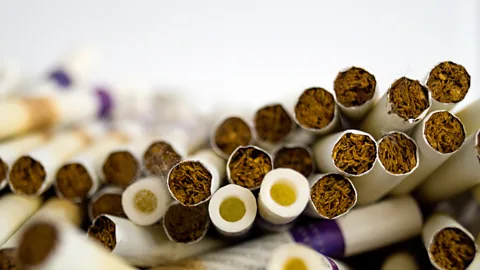 Getty Images
Getty ImagesBut the debate over the marketing of heated tobacco also obscures another issue – these products are so new that there is still little research to assess their long-term health effects.
Most research on the vapour emissions from heated tobacco products have been funded by tobacco companies or carried out by scientists directly employed by them. They show that heated tobacco aerosols contain significantly fewer harmful compounds than cigarette smoke.
Some studies have also found that switching from cigarettes to heated tobacco can be beneficial in some people – such as patients with chronic lung disease. But other scientific research also suggests that heated tobacco products are unlikely to be benign for our health.
In 2017, a group of Swiss scientists published a study disputing one of PMI's central marketing claims, namely that IQOS is smoke-free because of the lack of combustion or burning of the tobacco leaves.
Instead, the researchers argue that the emissions from heated tobacco devices should still be considered as "smoke" and should fall under indoor smoking bans in the same way as cigarettes. Their study showed that IQOS tobacco reaches around 330C (626F), a finding supported by other studies, while a conventional cigarette reached around 684C (1,263F).
In their subsequent analysis of IQOS emissions, they concluded that the heated tobacco vapour also contained harmful chemicals which stem from pyrolysis – the term for incomplete combustion – and thermogenic degradation, making it more similar to cigarette smoke than the company was claiming. "Smokers and non-smokers need accurate information about toxic compounds released in IQOS smoke," the scientists wrote.
PMI was quick to respond to the study, sending the authors a letter disputing many of the results. A subsequent analysis by the FDA also warned there were "significant analytical issues" with the study that made it difficult to compare the levels of harmful and potentially harmful compounds from heated tobacco to those from cigarettes. PMI maintains that IQOS heats tobacco but does not burn it.
Other research, however, has examined the type and quantity of toxins present in the vapours produced by heated tobacco.
At the National Technical University of Athens, chemical engineer Efthimios Zervas has spent much of the past decade painstakingly analysing the chemicals present in the fumes of products including IQOS and glo. He describes it as a slow and complex process because the fumes emitted contain many thousands of different chemicals, in combinations that vary greatly from one product to another.
"We try to study as much as we can, but it's difficult because as soon as we publish our results, this product we've been analysing has either been modified or is no longer on the market," he says. "So you're constantly playing catch-up with the industry."
Still, Zervas has drawn a number of conclusions. As with cigarettes, he has found that heated tobacco products release high concentrations of fine particles, capable of penetrating deep into the body. Other studies have identified known toxins present in the gaseous emissions. Indeed, many toxins and carcinogens were present at far lower concentrations in heated tobacco vapours than in fumes from cigarettes. But Zervas has found others, such as carbonyl methylglyoxal, that he says are actually emitted in higher concentrations by heated tobacco products.
"There are toxic products in there, so we cannot say that these devices are safe," says Zervas.
PMI says that its own research indicates that IQOS does not generate solid particles in the aerosol it emits.
Industry-backed studies have also reported a long list of compounds in the aerosols from heated tobacco – one study by BAT found more than 120 while another detected 205 compounds in the aerosols, including 82 not seen in cigarette smoke. These include compounds that are the result of heating glycerol, which is one of the ingredients in heated tobacco sticks. The WHO has called for more research to evaluate the effect of these compounds on human health when inhaled at the relatively high levels in heated tobacco aerosols.
Meanwhile early studies in animals indicate that there may be some long-term effects of heated tobacco on cardiovascular health and the central nervous system, but these results are yet to be seen in humans.
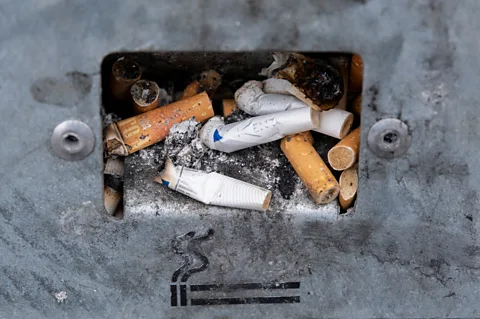 Getty Images
Getty ImagesSuch sentiments have been noted by regulators. While the US Food and Drug Administration (FDA) has authorised PMI to market multiple heated tobacco products, it also declared that this "does not mean these products are safe nor FDA approved". The FDA also says, "There are no safe tobacco products, so those who do not currently use tobacco products, especially young people, should not start."
All three of the tobacco companies the BBC spoke to acknowledge that it would be incorrect to say heated tobacco products are safe or risk free. But they say research indicates that they provide a way of reducing exposure to harmful compounds if smokers switch from cigarettes to heated tobacco products.
"This fundamental principle underpins the promise that smoke-free products like IQOS hold for advancing global health and further validates PMI's commitment to a smoke-free future," says Moira Gilchrist, PMI's global chief communications officer.
"The majority of risk associated with cigarettes comes from the burning of tobacco and not the nicotine," says a BAT spokesperson. "glo, while not risk free, does not involve burning tobacco." Footnotes in their response, however, added that their statement assumes a complete switch from cigarette smoking and notes that their product is addictive and not risk free.
"JTI does not market any of its products including heated tobacco products as smoking cessation products," says a JTI spokesperson. "They are an alternative for smokers looking for products with the potential to reduce the risks associated with smoking."
There are some who question the science that major companies are using to promote heated tobacco products. The European Respiratory Society Tobacco Control Committee published a position paper in February 2024 on the subject. The paper states that, while the tobacco industry claims a 90-95% reduction in harmful and potentially harmful substances and toxicity for heated tobacco products, this is not the full picture. Independent research shows these products emit substantial levels of carcinogenic, tobacco-specific nitrosamines, irritants and potential carcinogens, as well as similar nicotine and tar levels to a standard cigarette, the paper states.
Some researchers have also cast doubt on the clinical trials conducted by tobacco companies themselves. In 2022, a systematic review by the University of Bath's Tobacco Control Research Group – which receives funding from Bloomberg Philanthropies and are part of STOP, a global tobacco industry watchdog – concluded that PMI's clinical trials of its heated tobacco products were of poor quality and at high risk of bias.
PMI did not provide a response to these allegations when asked by the BBC, but it characterised the University of Bath's Tobacco Control Research Group as an "unreliable and inaccurate source of information". It did not provide any further evidence to support this accusation.
 Getty Images
Getty ImagesWith other forms of smokeless tobacco also on the rise, which can be chewed, sucked or snuffed, many anti-tobacco lobbyists are frustrated by the lack of progress. Staying ahead of the proliferation of new forms of tobacco consumption is like playing a game of "whack-a-mole", says Sandra Mullin, senior vice-president of policy, advocacy and communication at Vital Strategies, an international non-profit organisation that has partnered with governments around the world to develop tobacco control policies.
"I was in China in January, and they showed us these new models of heated tobacco products that don't look like tobacco, they look like a toy," she says, adding that she would like to have more data that demonstrates whether there are serious health impacts from such products.
One aspect that is particularly worrying public health officials, including the WHO, is that these devices may actually encourage people to consume more tobacco. A 2022 systematic review by researchers in the UK concluded that there was insufficient evidence to show they help people to stop smoking. The 2023 WHO report on heated tobacco also warns that the available data indicates that most smokers become dual users and "do not substantially reduce their risk from tobacco products".
Gallus and his colleagues recently published a review of 26 studies on the use of heated tobacco products conducted around the world since 2022. Two out of three heated tobacco users are dual users, he and his colleagues concluded.
According to Gallus, dual users have a significantly higher risk of disease and premature death compared with smokers.
"If you're not actually reducing tobacco consumption, it undoes any potential reduced harm effects, and the industry's just making money from people twice over," says Sophie Braznell, a researcher in the University of Bath's Tobacco Control Research Group and a spokesperson for STOP.
PMI claims its own data demonstrates the majority of IQOS users have given up smoking. It estimates 72% of IQOS users are people who have fully switched from cigarettes. JTI and BAT did not respond to questions about dual use of their products.
But with IQOS returning to the US, starting with the devices going on sale in Austin, Texas in March 2025, Yolonda Richardson, president and chief executive of the Campaign for Tobacco-Free Kids, is concerned that more people will become users of multiple tobacco or nicotine products. E-cigarettes remain popular among younger people while nicotine pouches that are placed between the lip and gum are now showing signs of growing in popularity, with the CDC reporting a substantial increase in nationwide sales in the US since 2016.
However, Richardson says that it may take a long time before the full health consequences become apparent. When they do, it will be exceedingly difficult to pinpoint the underlying source, as individuals will have been exposed to different concentrations of nicotine in different forms, as well as varying sources of tobacco.
Zervas argues that the onus should be on the tobacco industry to prove that its products are not dangerous before they're able to enter the market, rather than the other way round.
"It's like with food or drugs," he says. "We study them first and, if they're safe, we allow them. With the tobacco industry's products, we allow them into the market and then have to prove they're dangerous, or very dangerous."
* This article was updated on 2 May 2025 to make clear that the FDA issued additional authorisation for IQOS to be marketted in the US in 2020.
--
For trusted insights into better health and wellbeing rooted in science, sign up to the Health Fix newsletter, while The Essential List delivers a handpicked selection of features and insights.
